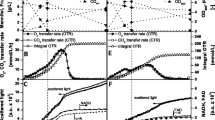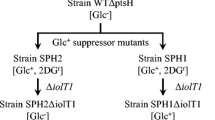Abstract
Glucose-dehydrogenase-deficient (Gcd−) strains ofPseudomonas cepacia 249 compensated for loss of operation of the direct oxidative pathway by expanding the phosphorylative pathway. When grown on glucose, they had between two- and fourfold higher than normal levels of glucokinase and NAD-linked glucose-6-phosphate dehydrogenase activity and a comparable increase in capacity to transport glucose. Similar expansion of the phosphorylative pathway was noted when the wild type was grown on cellobiose or trehalose. Gcd− strains grew normally on cellobiose and trehalose, but not if also deficient in glucokinase; this indicates that the disaccharides were converted to glucose and metabolized via the phosphorylative pathway. The expansion of the phosphorylative pathway during growth of the wild type on disaccharides or of Gcd− mutants on glucose was a consequence of hyperinduction of pathway enzymes. Other compounds that promoted such hyperinduction included aromatic conjugates of glucose such as arbutin and salicin, and mannose. Under conditions leading to expansion of the phosphorylative pathway, enzymes related to the direct oxidative pathway, such as gluconate dehydrogenase and the 6-phosphogluconate dehydrogenase active with NAD, were not formed. The results indicate that intracellular glucose and extracellular glucose are metabolized to 6-phosphogluconate via different routes.
Similar content being viewed by others
Literature Cited
Allenza, P., Lee, Y. N., Lessie, T. G. 1982. Enzymes related to fructose utilization inPseudomonas cepacia. Journal of Bacteriology150:1348–1356.
Allenza, P., Lessie, T. G. 1982.Pseudomonas cepacia mutants blocked in the Entner-Duodoroff pathway. Journal of Bacteriology150:1340–1347.
Berka, T. R., Lessie, T. G. 1984. Enzymes related to galactose utilization inPseudomonas cepacia. Current Microbiology11:43–48.
Cacciapuoti, A. F., Lessie, T. G. 1977. Characterization of the fatty acid sensitive glucose-6-phosphate dehydrogenase fromPseudomonas cepacia. Journal of Bacteriology132:555–563.
Campbell, J. J. R., Hogg, L. A., Strasdine, G. A. 1962. Enzyme distribution inPseudomonas aeruginosa. Journal of Bacteriology83:1155–1160.
Eisenberg, R. C., Butters, S. J., Quay, S. C., Friedman, S. B. 1974. Glucose uptake and phosphorylation inPseudomonas fluorescens. Journal of Bacteriology120:147–153.
Frampton, E. W., Wood, W. A. 1961. Carbohydrate oxidation byPseudomonas fluorescens. VI. Conversion of 2-keto-6-phosphogluconate to pyruvate. Journal of Biological Chemistry236:2571–2577.
Hunt, J. C., Phibbs, P. V., Jr. 1983. Regulation of alternate pathways of glucose catabolism during aerobic and anaerobic growth ofPseudomonas aeruginosa. Journal of Bacteriology.154:793–802.
Hyvarinen, A., Nikkila, A. 1962. Specific determination of blood glucose witho-toluidine. Clinica Chemica Acta.7:140–143.
Lee, Y. N., Lessie, T. G. 1974. Purification and characterization of the two 6-phosphogluconate dehydrogenase species fromPseudomonas multivorans. Journal of Bacteriology120:1043–1057.
Lessie, T. G., Berka, T., Zamanigian, S. 1979.Pseudomonas cepacia mutants blocked in the direct oxidative pathway of glucose degradation. Journal of Bacteriology139:323–325.
Lessie, T. G., Neidhardt, F. C. 1967. Adenosine triphosphatelinked control ofPseudomonas aeruginosa glucose-6-phosphate dehydrogenase. Journal of Bacteriology93:1337–1345.
Lessie, T. G., Vander Wyk, J. C. 1972. Multiple forms ofPseudomonas multivorans glucose-6-phosphate dehydrogenases: differences in size, pyridine nucleotide specificity, and susceptibility to inhibition by adenosine 5-triphosphate. Journal of Bacteriology110:1107–1117.
Lowry, O. H., Rosebrough, N. J., Farr, A. L., Randall, R. J. 1951. Protein measurement with the Folin phenol reagent. Journal of Biological Chemistry193:265–275.
Matsushita, K., Ameyama, M. 1982. D-glucose dehydrogenase fromPseudomonas fluorescens, membrane-bound. Methods in Enzymology89:149–154.
Matsushita, K., Shinagawa, E., Ameyama, M. 1982. D-gluconate dehydrogenase from bacteria, 2-keto-D-gluconate-yielding, membrane-bound. Methods in Enzymology89:187–193.
Midgley, M., Dawes, E. A. 1973. The regulation of transport of glucose and methyl-glucoside inPseudomonas aeruginosa. Biochemical Journal132:141–154.
Mitchell, C. G., Dawes, E. A. 1982. The role of oxygen in the regulation of glucose catabolism, transport, and the tricarboxylic acid cycle inPseudomonas aeruginosa. Journal of General Microbiology128:49–56.
Nandassa, H. G., Andreesen, M., Schlegel, H. G. 1974. The utilization of 2-ketogluconate byHydrogenomonas eutropha. Archives of Microbiology103:71–76.
Narrod, S. A., Wood, W. A. 1956. Carbohydrate utilization byPseudomonas fluorescens: evidence for gluconokinase and 2-ketogluconokinase. Journal of Biological Chemistry.220:45–55.
O'Brien, R. W. 1975. Enzymatic analysis of pathways of glucose catabolism inPseudomonas citronellolis. Archives of Microbiology103:71–76.
Palleroni, N. J., Doudoroff, M. 1972. Some properties and taxonomic subdivisions of the genusPseudomonas. Annual Review of Phytopathology10:73–100.
Quay, S. C., Friedman, S. B., Eisenberg, R. C. 1972. Gluconate regulation of glucose catabolism inPseudomonas fluorescens. Journal of Bacteriology112:291–298.
Roberts, B. K., Midgley, M., Dawes, E. A. 1973. The metabolism of 2-oxogluconate byPseudomonas aeruginosa. Journal of General Microbiology78:319–329.
Stanier, R. Y., Palleroni, N. J., Doudoroff, M. 1966. The aerobic pseudomonads: a taxonomic study. Journal of General Microbiology43:159–271.
Tiwari, N. P., Campbell, J. J. R. 1969. Enzymatic control of metabolic activity ofPseudomonas aeruginosa. Biochimica et Biophysica Acta193:395–401.
Vander Wyk, J. C., Lessie, T. G. 1974. Purification and characterization of thePseudomonas multivorans glucose-6-phosphate dehydrogenase active with nicotinamide adenine dinucleotide. Journal of Bacteriology120:1033–1042.
Vincente, M., Canovas, J. L. 1973. Glucolysis inPseudomonas putida—physiological role of alternative routes from the analysis of defective mutants. Journal of Bacteriology116:908–914.
Author information
Authors and Affiliations
Rights and permissions
About this article
Cite this article
Berka, T.R., Allenza, P. & Lessie, T.G. Hyperinduction of enzymes of the phosphorylative pathway of glucose dissimilation inPseudomonas cepacia . Current Microbiology 11, 143–148 (1984). https://doi.org/10.1007/BF01567339
Issue Date:
DOI: https://doi.org/10.1007/BF01567339




